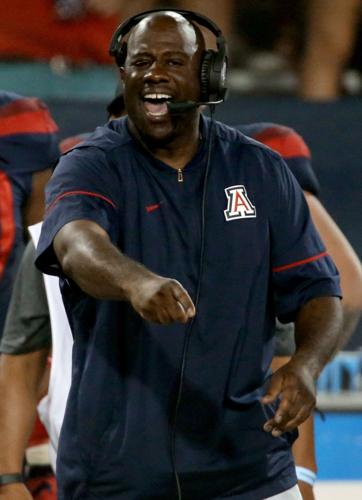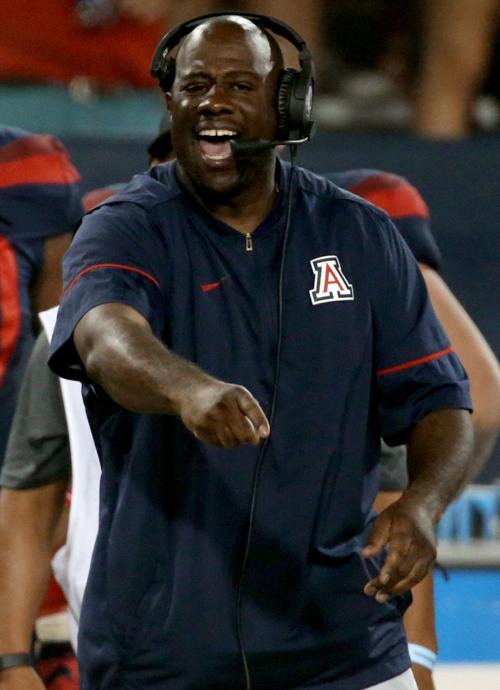
Editor’s note
Each week throughout the football season, we’ll take an in-depth look at the Arizona Wildcats from a statistical perspective.
The question arose during a segment on SiriusXM’s Pac-12 Radio channel, and it’s a fascinating what-if scenario to ponder:
Would Marcel Yates still have his job as Arizona Wildcats defensive coordinator if Stanford quarterback K.J. Costello hadn’t returned from injury last week?
Costello made all the difference for the Cardinal, who barely could move the ball the previous week with untested third-stringer Jack West at quarterback. The performance of the UA defense in the first half of that game proved to be Yates’ undoing, as Kevin Sumlin confirmed two days later. Chuck Cecil will run the defense when Arizona hosts Oregon State on Saturday.
A different outcome at Stanford might have just delayed the inevitable. It’s entirely possible Sumlin would have moved on from Yates after this season, citing a lack of overall progress on that side of the ball.
We’ll examine some of those numbers in this week’s “Cats Stats.” One in particular can be linked to Yates’ demise. We’ll get there in a bit.
Let’s start with the basics. Yates came to the UA from Boise State in 2016. He inherited a defense that ranked ninth or worse in the Pac-12 in the seven categories we’re going to focus on today: points allowed, total defense, rushing defense, passing defense, sacks, takeaways and third-down percentage.
The Wildcats basically held serve in terms of league rankings the following season, but the numbers were noticeably worse in points allowed per game (38.3, up from 35.8) and opponent third-down percentage (52.6%, up from 46.2%).
Yates had some legitimate excuses, though. By the time he came aboard in January 2016, most of Arizona’s recruiting class had been finalized. It was also a hellacious season from an injury standpoint on both sides of the ball, and the Wildcats finished 3-9 — their lone sub-.500 record during Rich Rodriguez’s six seasons as head coach.
Arizona embraced a youth movement on defense the following season, starting four true freshmen and one redshirt freshman for the majority of the year. Yates had a hand in recruiting several of them.
The defense improved in several categories, including points allowed per game (34.4), sacks (31, up from 22), third-down percentage (46.7) and takeaways (25, up from 14). The Wildcats still ranked ninth or worse in the Pac-12 in five of our seven categories, but the young players showed promising signs. The future felt bright.
The UA fired Rodriguez after the season. Sumlin, who had worked with Yates at Texas A&M, kept him to preserve continuity on at least one side of the ball.
The scheme would remain the same, the freshmen would now be sophomores and another batch of recruits would arrive to enhance the talent and depth. All the pieces seemed to be in place for a defensive breakthrough.
It didn’t happen. Arizona ranked ninth or worse in the Pac-12 in six of our seven stat categories, with rushing defense (162.5 yards allowed per game; eighth) being the lone exception.
But if you looked a little closer, you could see some favorable indicators. Arizona allowed fewer points per game (32.6) for the second straight season, and its defensive third-down percentage (41.1) also improved for the second year in a row. The Wildcats surrendered nearly 40 fewer yards per game (432) than the previous season (471.2).
Then came the 2019 opener at Hawaii, which looked and felt like a step backward — maybe even several. Arizona surrendered 595 yards — more than in any game the previous season other than the Washington State debacle — and 45 points. It would have been even worse had the defense not taken the ball away six times. UA fans were not pleased.
They didn’t feel great after the next game either, in which Arizona allowed 28 second-half points in a blowout win over NAU. But the defense came up big in wins against Texas Tech and UCLA, allowing a combined 31 points. It came up clutch in a rare road victory at Colorado, making just enough stops in the fourth quarter.
In losses to Washington and USC, the defense kept Arizona in the game for as long as it could while the Wildcats’ offense and special teams sputtered. The dam eventually broke in both contests. UW scored 38 of its 51 points in the second half; USC put up 27 of its 41 after halftime.
UA was a sizable underdog in each game. It wasn’t surprising that the Wildcats lost. The offense, deservedly, attracted more scrutiny heading into Stanford.
The Cardinal ranked 11th in the Pac-12 in several major offensive categories. Costello had missed about half the season because of injuries. But even when he played, Stanford had trouble moving the ball.
The Cardinal had no such issues against the Wildcats. Stanford amassed 327 yards and 31 points in the first half alone. The defense recovered in the second half, allowing only 10 points, but the damage had been done.
Entering this week’s game, Arizona ranks last or next-to-last in the Pac-12 in points allowed per game (35), total defense (469.9 yards allowed per game), passing defense (311.6 yards allowed per game) and sacks (seven). The Wildcats rank seventh in rushing defense (158.3 yards allowed per game), a category in which they improved every year under Yates.
They rank fifth in takeaways, but that’s misleading. After that opening-night six-pack, Arizona has forced seven turnovers in the past seven games and just three in the past five.
It isn’t hard to figure out why those numbers have plummeted. The Wildcats have the worst pass rush among the 64 teams in the Power Five conferences.
Arizona’s seven sacks rank last in P5, as does its yardage lost on sacks (33). The next-closest team in the Pac-12, Colorado, has nearly twice as many sacks (13). Oregon State, not exactly known for its dominant defense in recent seasons, has 21 in seven games.
Arizona is on pace for 11 sacks, which would be its second-lowest total since joining the Pac-12 in 1978. The Wildcats are on pace for 50 yards in losses, which would be a historically low amount.
To put it in perspective: Arizona’s previous low over the previous five seasons was 132 yards in 2018.
The ’19 Wildcats rarely have put the opposition in compromising positions. Among Power 5 conference schools, only Colorado has fewer tackles for losses than Arizona’s 32. None has accumulated less TFL yardage.
The Wildcats’ stops behind the line of scrimmage have added up to 94 yards in losses. That puts them on pace for 141. Their lowest total over the past five years: 237 in 2016.
Arizona didn’t sacked Costello and seldom hit him. His 312 passing yards and three touchdowns easily were season highs.
While linebacker Colin Schooler is well off his TFL pace from last season, the defensive line’s dearth of sacks is a much greater concern. End Jalen Harris has 3.5. The rest of the line has combined for two.
Yates primarily relied on three or four rushers to get to the quarterback, and they haven’t reached their destination nearly enough this season.
It should be noted that defensive line is the only position Yates never coached. But as the coordinator, he was responsible for the entire defense. He never found a way to overcome its deficiencies.






